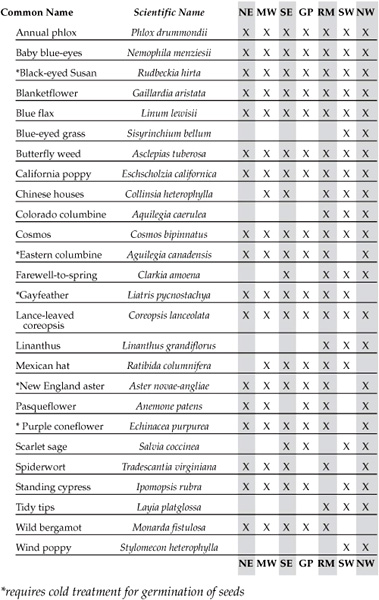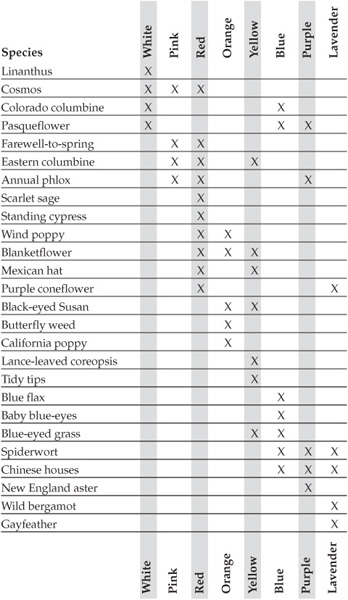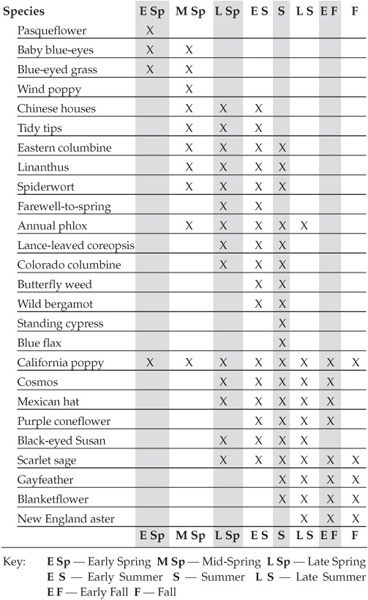Creating a Wildflower Meadow
Henry W. Art
Introduction
Whether your backyard is the size of a postage stamp or the back 40, wildflowers can enhance its beauty and add to your enjoyment. This bulletin describes how to grow meadow wildflowers that like plenty of sun and can fill either large or small yards with a seasonal procession of colors. You may desire to convert a portion of the lawn to which you have been enslaved into a beautiful natural landscape. Wildflower meadows cost less than lawns to maintain, and consume much less water, gasoline, fertilizer, and time. On the other hand, you may wish to introduce some native species into existing gardens to supplement your familiar border and bedding plants. In either case, wildflowers can be established with modest investments of time in planning, preparation, properly selected seeds, and patience.
In addition to providing low-maintenance landscaping, wild-flowers are extremely versatile. If portions of your yard are too dry or too wet for the usual lawn grasses, certain wildflowers mixed with native grasses may be a beautiful solution to the problem. Many of the species in this bulletin (such as black-eyed Susan, butterfly weed, and purple coneflower) will attract butterflies to your garden. Scarlet sage and standing cypress, with their bright red flowers, are pollinated by hummingbirds. These species and others (such as gayfeather, blanketflower, and wild bergamot) make excellent cut flowers as well.
Selecting Wildflowers
The wildflowers I suggest you consider have been selected because they are native to North America, reasonably easy to grow, and are well behaved once established. Although some of these wildflowers are native only to a specific region, all of them can be grown over a wide range of environmental conditions in other regions as well. There are many other species that could easily be added to your backyard and you might want to consult A Garden of Wildflowers, The Wildflower Gardeners Guide, or other references listed on page 29 for further suggestions.
When I use the term wildflower I am referring to species of plants that can grow on their own with little or no attention from the gardener. Weeds are one form of wildflower, but are not recommended in this bulletin. While some species such as ox-eye daisy and chicory may be attractive, they also may become aggressive and take over your backyard. The following is a short list of alien (non-native) wildflower species that should be avoided for that reason.
Alien Wildflower Species
African daisy
Babys breath
Bachelors button
Bouncing Bet
Candytuft
Chicory
Corn poppy
Cornflower
Dames rocket
Four-oclock
Foxglove
Ox-eye daisy
Purple loosestrife
Queen Annes lace
St. Johns-wort
Silene
Sweet alyssum
White yarrow
For best results, the wildflowers you choose should be compatible with the environmental conditions typical to your region. The list of wildflowers on page 4 is keyed to the regional map on page 5, and can be used as a general guide for the selection of wildflowers. More information about these wildflowers appears on pages 16 29.
WILDFLOWERS BY REGION

WILDFLOWER & GRASS REGION MAP

Some wildflowers are hardy and tolerate freezing temperatures, while others are tender and are killed by frosts. Take your local climate into consideration when selecting wildflowers, remembering that sunny southern slopes are usually warmer, and shady northern slopes may be substantially cooler, than the average climate of a region. For example, if you live in a northern region you may be able to grow more southerly wildflowers on south-facing, protected slopes.
You will probably want to plant several different species of wild-flowers, drawn from a rich palette of complementary colors and giving a seasonal succession of bloom. To help you make your choices, the tables on pages 6 and 7 arrange the wildflowers by color and by season of flowering.
COLOR

FLOWERING PROGRESSION

How to Obtain Wildflowers
Wildflowers should never be dug from the wild except as part of a rescue operation to save plants that would otherwise be destroyed. Wildflowers are usually propagated either by making cuttings and divisions or by planting seeds. There are a growing number of reputable wildflower propagators who grow their own stock rather than digging plants from the wild. Many of these suppliers will take phone and mail order requests for wildflowers. However, live plants are quite expensive, perhaps prohibitively so if you intend to plant a large area.
By far the least expensive means of growing wildflowers is from seed. The quickest way to obtain wildflower seeds is to purchase them from a reputable supplier. Seeds are generally available year-round and can easily be sent through the mail. If you are planning to plant large areas, you should inquire about wholesale prices for wildflower and native grass seeds. The names of several suppliers are listed on page 30, but their inclusion on the list is by no means an endorsement. The names of other seed companies can be obtained from your nearest native plant society, botanical garden, or U.S. Department of Agriculture Extension Service agent.
Use caution before using prepared wildflower seed mixtures. Although some suppliers will carefully formulate mixes especially for your region using high-quality native species, others simply add the cheapest, most readily available seeds regardless of their desirability. If you are going to spend your money on wildflower seeds, you might as well purchase species that will survive well in your region and not pay for roadside weedy wildflowers (such as those listed on page 30) that you wouldnt want in your backyard. So find out what is in the mixture of wildflower seed before you buy the can or packet.
By far the most pleasant way to obtain wildflower seeds is to collect them from the wild. If you collect seeds, remember to follow common sense conservation guidelines. Collect a few seeds or fruits from each of many plants and only from common species that are locally abundant. Be careful not to trample nearby plants while you are collecting. Do not collect fruits and seeds from plants growing in public places, and be sure to obtain permission from property owners before you collect on private property.
One of the most satisfactory ways to collect small seeds from wildflowers is to wait until the flowers start to wilt and then to make a small bag out of nylon stocking. Gently place a section of stocking over the developing fruits, and tie both ends using twist-ties, being careful not to crush the stem. When the fruits are fully ripe and dry, simply snip the stem and place the nylon bag into a paper sack.
It is best to separate the seeds from the dried remains of the fruit. Place the collected material on sheets of heavy white paper and gently crush the dried fruits. Blow gently across the paper to remove most of the unwanted husks and fruit residues, being careful not to blow the seeds away. A kitchen sieve is quite useful for cleaning small seeds. Put the seeds in small coin envelopes or zip-closure bags and store them in a cool, dry place.





